You’ll discover that Montana’s native plants can survive temperatures plunging to -40°F, yet many gardeners overlook these incredibly tough specimens when planning their landscapes. These hardy survivors, from drought-resistant prairie grasses to cold-adapted wildflowers, have spent thousands of years perfecting their strategies against Big Sky Country’s brutal conditions. What makes them so remarkably resilient might surprise you, and choosing the wrong varieties could mean watching your garden struggle while native alternatives would absolutely thrive.
Contents
- 1 Montana’s Harsh Winter Survival Requirements
- 2 Montana’s Best Wildflowers
- 3 Montana’s Hardy Native Trees
- 4 Montana’s Essential Native Shrubs
- 5 Selecting the Right Native Plants for Your Garden
- 6 Frequently Asked Questions
- 6.1 How Long Do Montana Native Plants Take to Establish After Planting?
- 6.2 Can Montana Native Plants Survive Drought Conditions Without Supplemental Watering?
- 6.3 Which Native Plants Attract Pollinators Like Bees and Butterflies in Montana?
- 6.4 Do Montana Native Plants Require Special Soil Amendments or Fertilizers?
- 6.5 When Is the Best Time of Year to Plant Native Species?
Montana’s Harsh Winter Survival Requirements
While Montana’s winters test even the hardiest gardeners, the state’s native plants have mastered survival mechanisms that put most imported species to shame. You’ll find cottonwoods beginning their “hardening” process each fall, triggered by dropping temperatures and shorter daylight hours. These winter plant adaptations involve remarkable cellular changes—trees relocate water from inside cells to intercellular spaces while increasing sugar concentrations. This prevents deadly ice crystal formation.
Montana natives also respond to shortened photoperiods by boosting dry-matter concentration in overwintering tissues. When extreme cold hits, ice develops a molten quality instead of sharp spicules that’d damage cell walls. Ancient specimens like white bark pine have demonstrated these survival strategies for millennia, with some forests surviving under ice for over five thousand years before revealing their secrets about past ecosystems.
Montana’s Best Wildflowers
Montana’s diverse landscapes host exceptional wildflowers, from the state’s official bitterroot to vibrant paintbrush, towering lupine, cheerful coneflowers, and delicate blue flax across various habitats. These native wildflowers create a peaceful garden aesthetic while supporting local ecosystems and wildlife throughout Big Sky Country.
Bitterroot (Lewisia Rediviva)
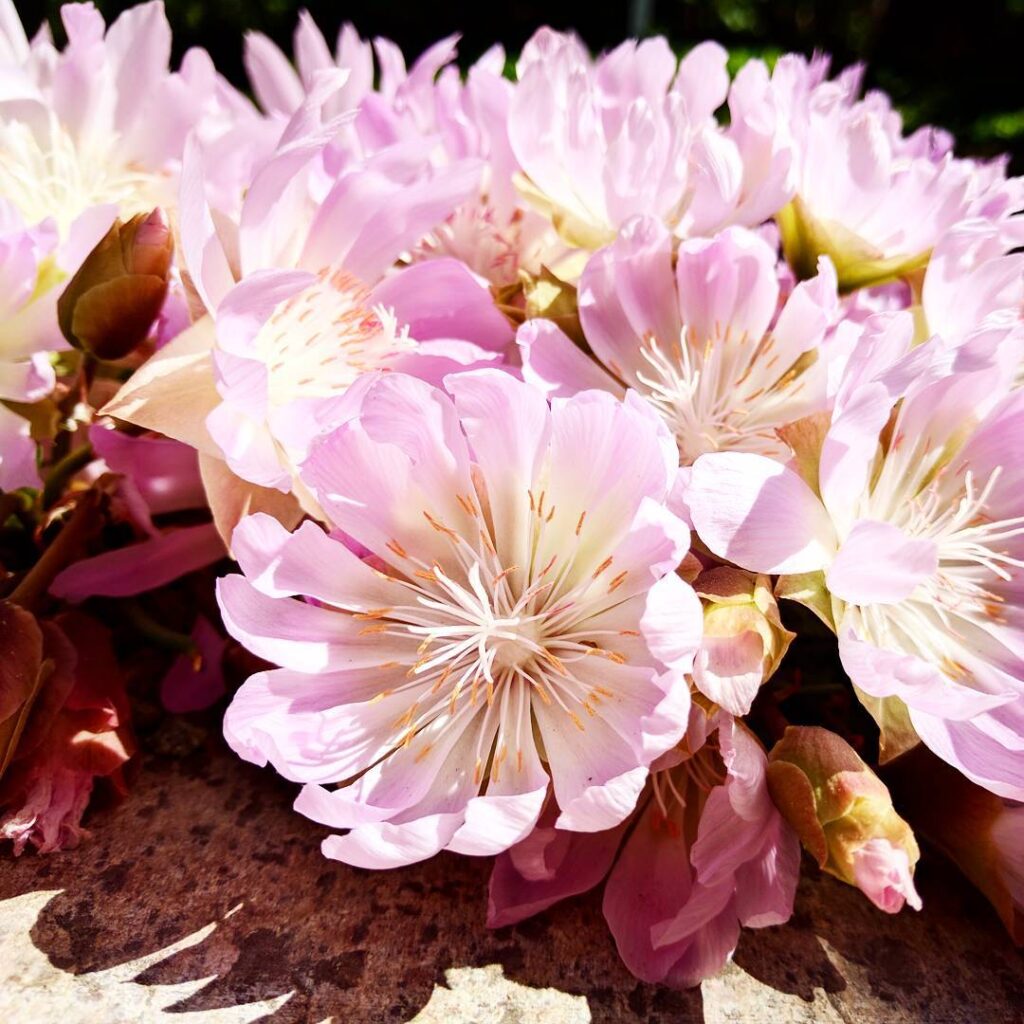
Bitterroot (Lewisia rediviva) is Montana’s official state flower and a remarkable perennial herb native to the intermountain west. This low-growing succulent produces stunning pink to white flowers up to 2 inches across, emerging nearly at ground level from April to July. Named after Captain Meriwether Lewis and meaning “revived,” it demonstrates extraordinary resilience through its ability to regenerate from seemingly dead roots.
The plant’s unique growth cycle features evergreen spoon-shaped leaves that form rosettes in fall, persist through winter, then often disappear before the spectacular blooms emerge. Its fleshy taproot stores water and nutrients, enabling survival in harsh, drought-prone environments where few other flowering plants can thrive. Indigenous peoples traditionally consumed the plant’s stout taproots as an important food source.
- Hardiness: USDA zones 4-8, extremely cold and drought tolerant
- Light: Full sun to partial sun, prefers exposed sites
- Water: Very low water requirements, drought tolerant once established
- Soil: Well-drained, rocky, gravelly, or sandy soils; intolerant of wet conditions
- Fertilizer: None required, adapted to poor soils
- Pest/Disease Resistance: Excellent resistance, few known issues
- Growth Rate: Slow to moderate, long-lived perennial
Indian Paintbrush (Castilleja)
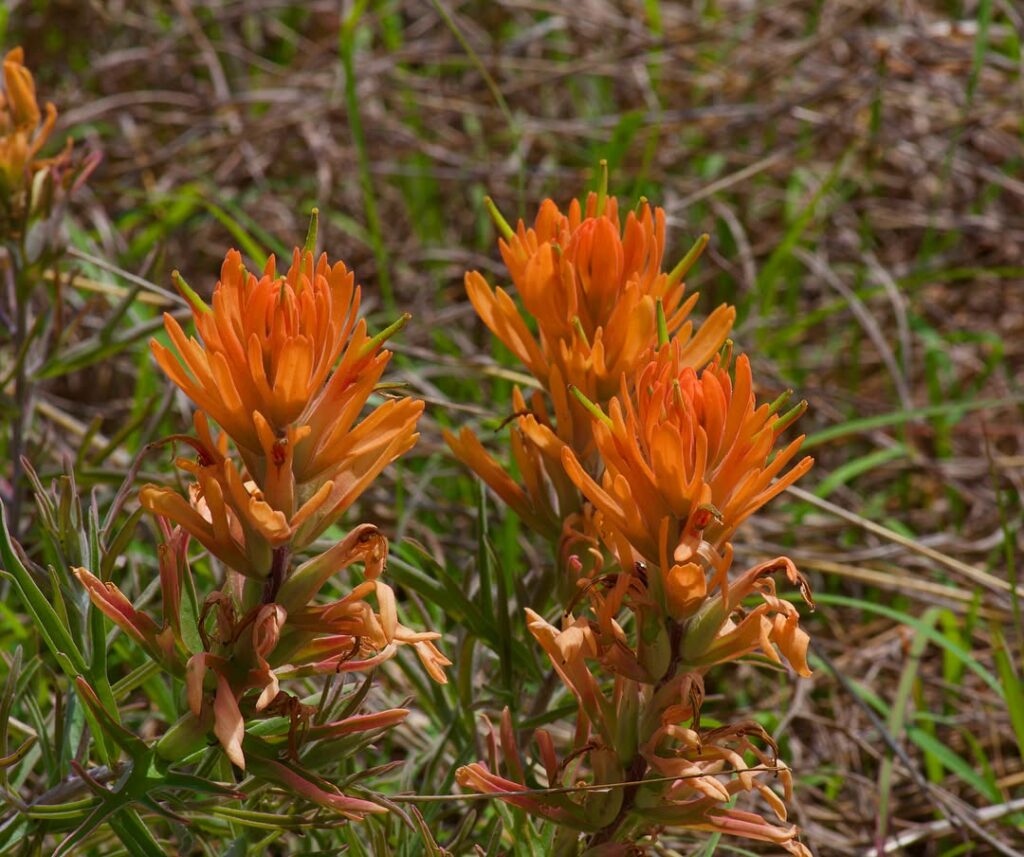
Indian Paintbrush (Castilleja) stands out as one of Montana’s most recognizable wildflowers, native to mountainous and prairie regions throughout the state. This distinctive plant creates its signature “paintbrush” appearance through brightly colored bracts in vibrant reds, oranges, and yellows rather than true petals. The tubular flowers emerge from spike-like inflorescences at the stem tips, blooming from July through August.
As a hemiparasite, Indian Paintbrush draws nutrients from neighboring plant roots while still photosynthesizing independently. This unique adaptation makes it challenging to cultivate in gardens but essential to native ecosystems. The vivid bracts attract specialized pollinators like hummingbirds and native bees, while the plant contributes to soil stabilization and biodiversity in prairie and mountain meadow habitats. Belonging to the Figwort family, Indian Paintbrush shares characteristics with other herbaceous plants known for their diverse forms and ecological adaptations.
- Hardiness: Cold hardy, adapted to Montana’s mountain and prairie conditions
- Light: Full sun with plenty of direct sunlight exposure
- Water: Moderate moisture requirements, drought tolerant once established
- Soil: Well-drained soils, thrives in rocky slopes and grasslands
- Fertilizer: Minimal needs due to hemiparasitic nature, requires host plants
- Pest/Disease Resistance: Generally resistant, well-adapted to native conditions
- Growth Rate: Moderate, with annuals reaching 30-80 cm and perennials 20-50 cm
Blanketflower (Gaillardia Aristata)
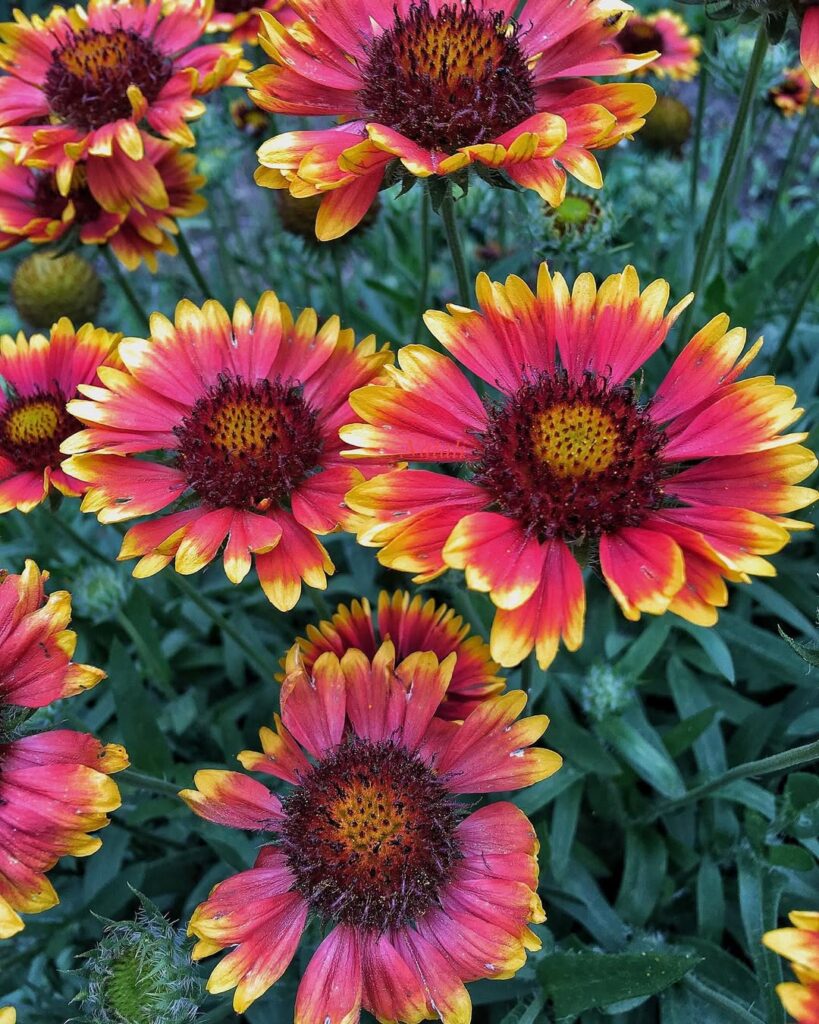
Blanketflower (Gaillardia aristata) is a stunning native perennial that exemplifies Montana’s resilient wildflower heritage. This member of the sunflower family produces continuous displays of vibrant daisy-like blooms from late spring through fall, featuring distinctive red-orange petals with golden yellow tips and dark red centers. Growing 1-3 feet tall with an 18-24 inch spread, blanketflower thrives in Montana’s challenging climate conditions.
Beyond its ornamental value, blanketflower serves as an essential pollinator plant while requiring minimal maintenance. Its grey-green fuzzy foliage remains attractive throughout the growing season, followed by distinctive puffball seed heads that attract goldfinches and other birds. This drought-tolerant native demonstrates exceptional adaptability to poor soils and extreme weather, making it a prime choice for xeriscaping and naturalized landscapes across Montana’s diverse growing zones.
- Hardiness: USDA zones 3-9, excellent cold tolerance
- Light: Full sun for peak growth and blooming
- Water: Low to moderate; drought tolerant once established
- Soil: Well-draining, lean to average soils; avoids wet clay conditions
- Fertilizer: Low requirements; thrives in poor soils
- Pest/Disease Resistance: Deer and rabbit resistant, generally pest-free
- Growth Rate: Moderate; reaches full size and blooms within weeks of spring planting
Wild Bergamot (Monarda Fistulosa)

Wild Bergamot (Monarda fistulosa) stands out as one of Montana’s premier native wildflowers, thriving across grasslands, prairies, and open forests throughout most of the state. This aromatic perennial herb in the mint family grows 1-3 feet tall, producing distinctive tubular lavender-pink flowers from June through August that release a characteristic minty fragrance when crushed.
Highly valued for its exceptional pollinator support, Wild Bergamot attracts diverse native bee species including bumblebees, mason bees, and leafcutting bees, making it essential for Montana’s agricultural research and crop pollination efforts. The plant also draws hummingbirds and butterflies with its nectar-rich blooms, further enhancing its value for wildlife habitat. Beyond its ecological importance, this adaptable wildflower serves multiple purposes in native plant gardens, prairie restoration projects, and traditional medicinal applications, while adding ornamental beauty to landscapes with its showy summer blooms.
- Hardiness: USDA zones 4-8, well-suited to Montana’s variable climate
- Light: Full sun to partial shade with good air circulation
- Water: Medium water use; tolerates dry to moist conditions, less tolerant of prolonged flooding
- Soil: Adaptable to sand, loam, or clay; acidic, neutral, or alkaline pH; well-drained but moist preferred
- Fertilizer: Low requirements as a native wildflower
- Pest/Disease Resistance: Susceptible to mildew in poor air circulation; generally hardy
- Growth Rate: Moderate perennial establishment
Rocky Mountain Bee Plant (Cleome)
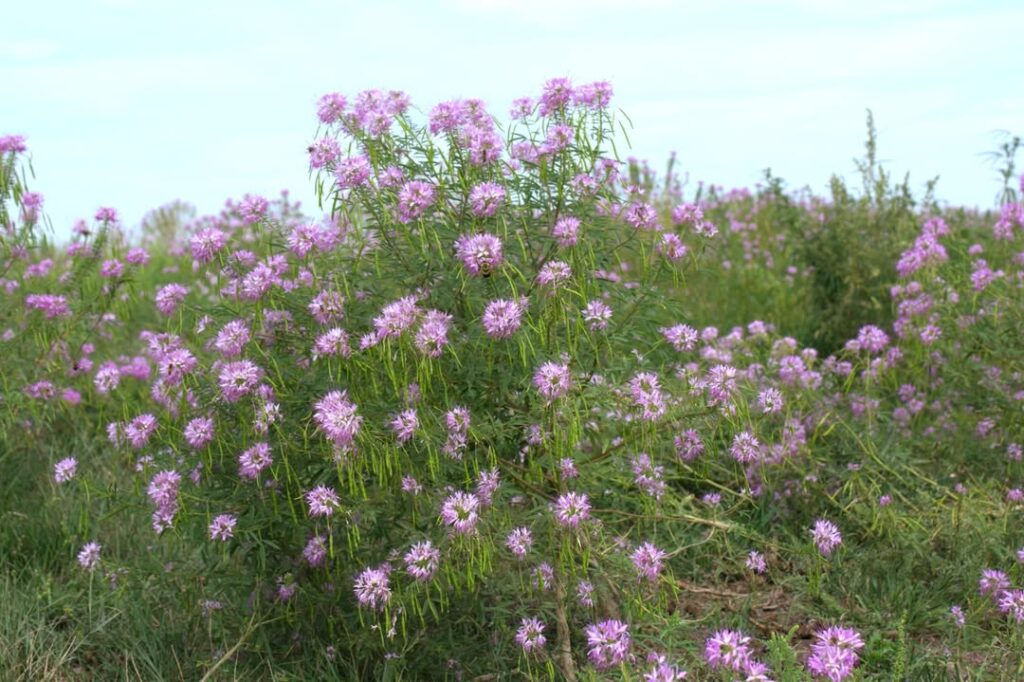
Rocky Mountain Beeplant is a striking native wildflower that grows 1-6 feet tall with bright pink and lavender blooms arranged in dense racemes. This upright annual features distinctive three-leaflet foliage and develops elongate pod-like capsules containing horseshoe-shaped seeds. With its long blooming season from May through September, it serves as a vital nectar source for pollinators throughout Montana’s growing season.
Previously classified as Cleome serrulata, this adaptable wildflower establishes readily in various conditions thanks to its deep 12-14 inch taproot system. The plant’s open, rangy structure topped with dozens of colorful flowers makes it both an attractive garden specimen and valuable addition to native plant communities across the Rocky Mountain region. For optimal establishment, use a seeding rate of 0.5 pounds per 1000 square feet.
- Hardiness: Annual plant adapted to Rocky Mountain conditions and various elevations
- Light: Full sun to partial sun
- Water: Prefers moist ground initially, becomes drought tolerant once established
- Soil: Adaptable to various soil types, benefits from well-draining conditions
- Fertilizer: Low maintenance, does not require supplemental fertilizing
- Pest/Disease Resistance: Generally resistant to common pests and diseases
- Growth Rate: Fast-growing annual, reaches mature height of 3-5 feet in one season
Montana’s Hardy Native Trees
Montana’s diverse climate and terrain support numerous hardy native tree species, from towering pines and firs to distinctive aspens and larches that define the state’s expansive forested landscapes. The majestic Ponderosa Pine serves as Montana’s state tree and can reach impressive heights of around 180 feet.
Ponderosa Pine (Pinus Ponderosa)
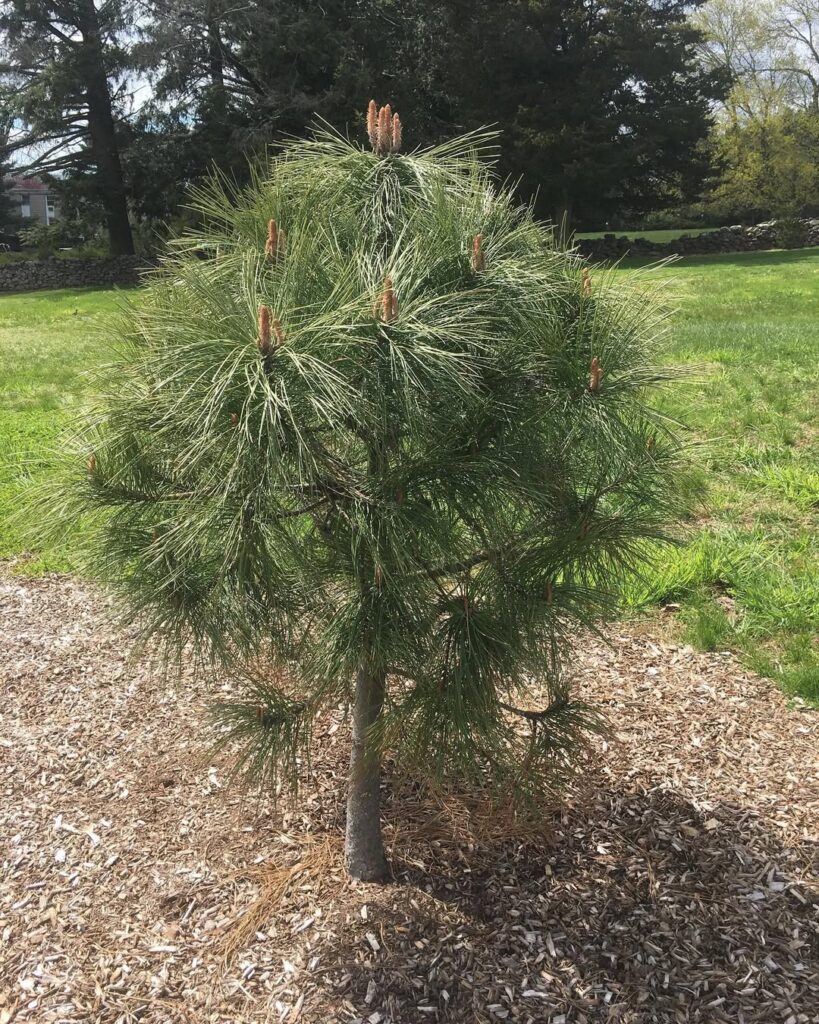
Ponderosa pine stands as Montana’s official state tree and most iconic conifer, thriving across the state’s mountainous terrain. This remarkable evergreen can live up to 600 years and reach heights of 200+ feet in ideal conditions. Distinguished by its distinctive bark that transforms from dark brown to bright orange-red with age, the tree produces long needles in bundles of three and emits a characteristic resinous fragrance.
Exceptionally well-adapted to Montana’s harsh climate, ponderosa pine demonstrates remarkable resilience to drought, fire, and extreme weather conditions through its thick insulating bark and extensive root system. The species forms extensive pure stands across western Montana and serves critical ecological functions, providing wildlife habitat while preventing soil erosion in mountainous regions. Native Americans historically utilized every part of the tree, consuming the sweet inner bark and seeds while using limbs for construction and needles for medicinal teas.
- Hardiness: USDA zones 3-7; tolerates extreme temperature variations and harsh mountain conditions
- Light: Full sun required; no shade tolerance
- Water: Drought-tolerant once established; prefers good moisture during establishment
- Soil: Well-drained sandy or gravelly loams; pH 4.9-9.1; avoids heavy clay or high silt content
- Fertilizer: Generally not required; adapted to nutrient-poor mountain soils
- Pest/Disease Resistance: Good resistance to most pests and diseases; thick bark provides fire resistance
- Growth Rate: Moderate to slow, especially in harsh mountain conditions
Rocky Mountain Juniper (Juniperus)
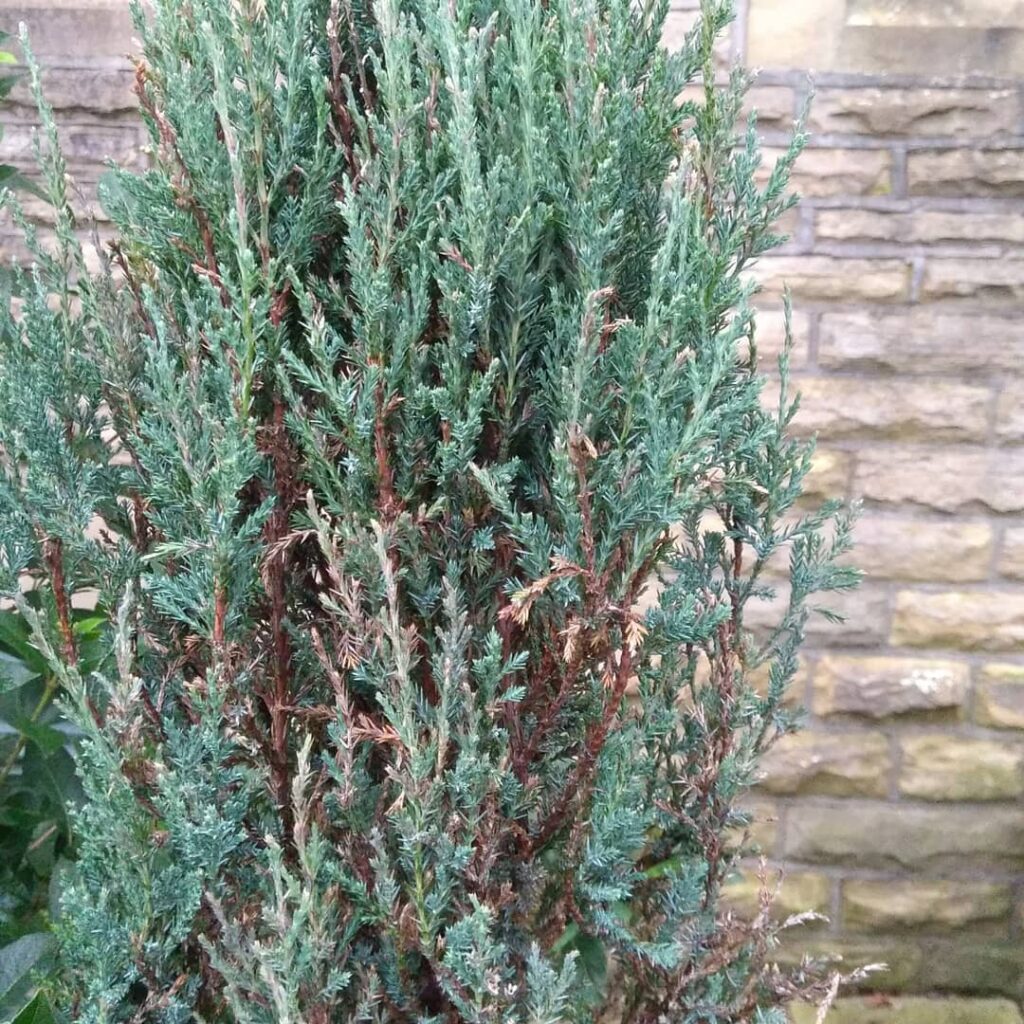
Rocky Mountain juniper (Juniperus scopulorum) is Montana’s most widely distributed native coniferous tree, thriving in the state’s challenging foothill and montane environments. This hardy species serves as a pioneer on exposed sites where other trees struggle, establishing scattered groves across rocky outcrops, bluffs, and changing zones between grasslands and forests.
With its distinctive reddish-brown peeling bark and dense scale-like foliage, Rocky Mountain juniper provides essential wildlife habitat while helping stabilize soils on steep slopes. The tree produces berry-like cones that feed numerous bird and mammal species, making it an ecological cornerstone in Montana’s drier mountain ecosystems. During winter months, the foliage becomes a critical food source for mule deer, potentially making up two-thirds of their winter diet.
- Hardiness: USDA zones 3-7, tolerates extreme temperature fluctuations and harsh mountain conditions
- Light: Full sun, thrives on exposed southern-facing slopes and open sites
- Water: Low to moderate; requires minimum 10 inches annually, drought tolerant once established
- Soil: Well-draining, rocky soils; adapts to diverse substrates including limestone, sandstone, and lava beds
- Fertilizer: None required; adapted to nutrient-poor soils
- Pest/Disease Resistance: Generally resistant due to harsh native growing conditions
- Growth Rate: Slow, especially in challenging sites
Quaking Aspen (Populus Tremuloides)
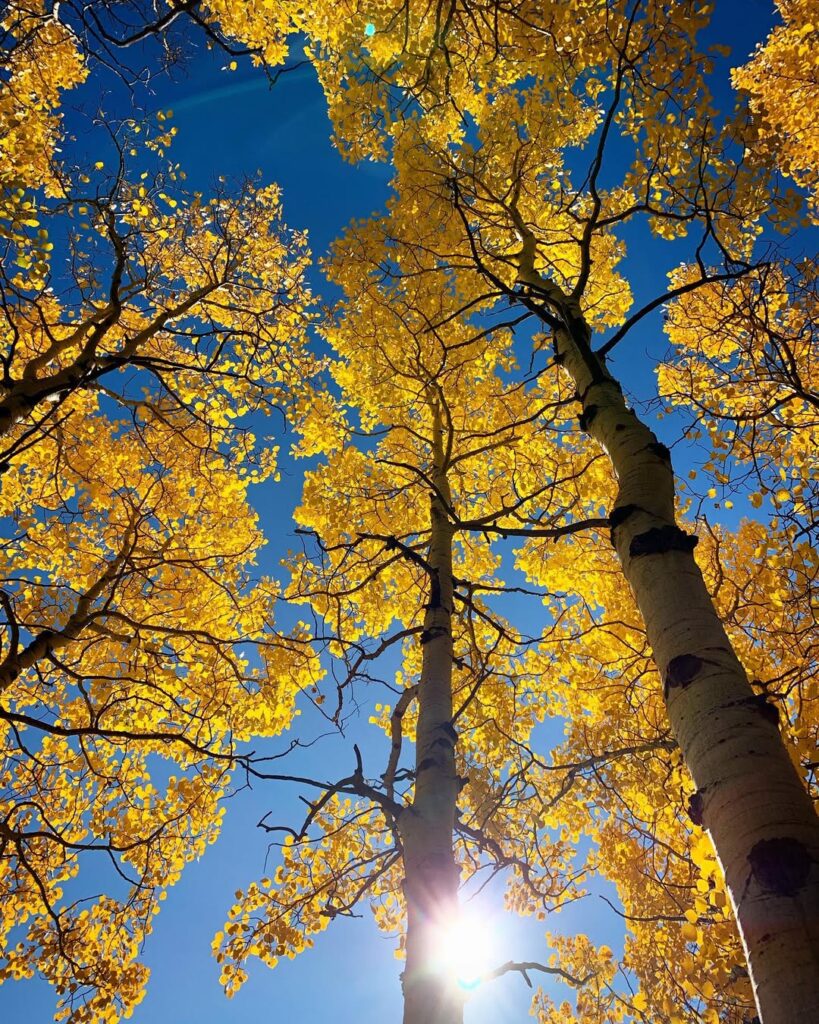
The Quaking Aspen (Populus tremuloides) stands as Montana’s most widely distributed native tree and a true ecological powerhouse. Recognizable by its smooth, pale bark with distinctive black scars and iconic trembling leaves that flutter in the slightest breeze, this deciduous tree reaches heights of 40-100 feet. Its unique flattened leaf petioles create the characteristic “quaking” motion that gives the species its name.
What makes aspen truly remarkable is its clonal reproduction system, where individual trees share interconnected root networks forming vast groves that can persist for millennia. These hardy trees serve as keystone species, supporting diverse wildlife through every season while demonstrating exceptional adaptability to Montana’s varied elevations, soil types, and moisture conditions from riparian areas to dry hillsides. This keystone species provides essential breeding, nesting, and cover habitat for birds and mammals while hosting various insects that serve as crucial food sources for wildlife.
- Hardiness: Extremely hardy, thriving across diverse Montana elevations from valleys to montane zones
- Light: Full sun to partial shade, often found in forest openings and edges
- Water: Adaptable to varied moisture; thrives with as little as 7 inches annual precipitation but prefers moist soils
- Soil: Highly adaptable to different soil types and conditions
- Fertilizer: Not required; thrives in natural soil conditions
- Pest/Disease Resistance: Moderate; susceptible to insect infestations and diseases but recovers well through clonal reproduction
- Growth Rate: Fast-growing, especially in disturbed sites and post-fire regeneration
Douglas Fir (Pseudotsuga Menziesii)
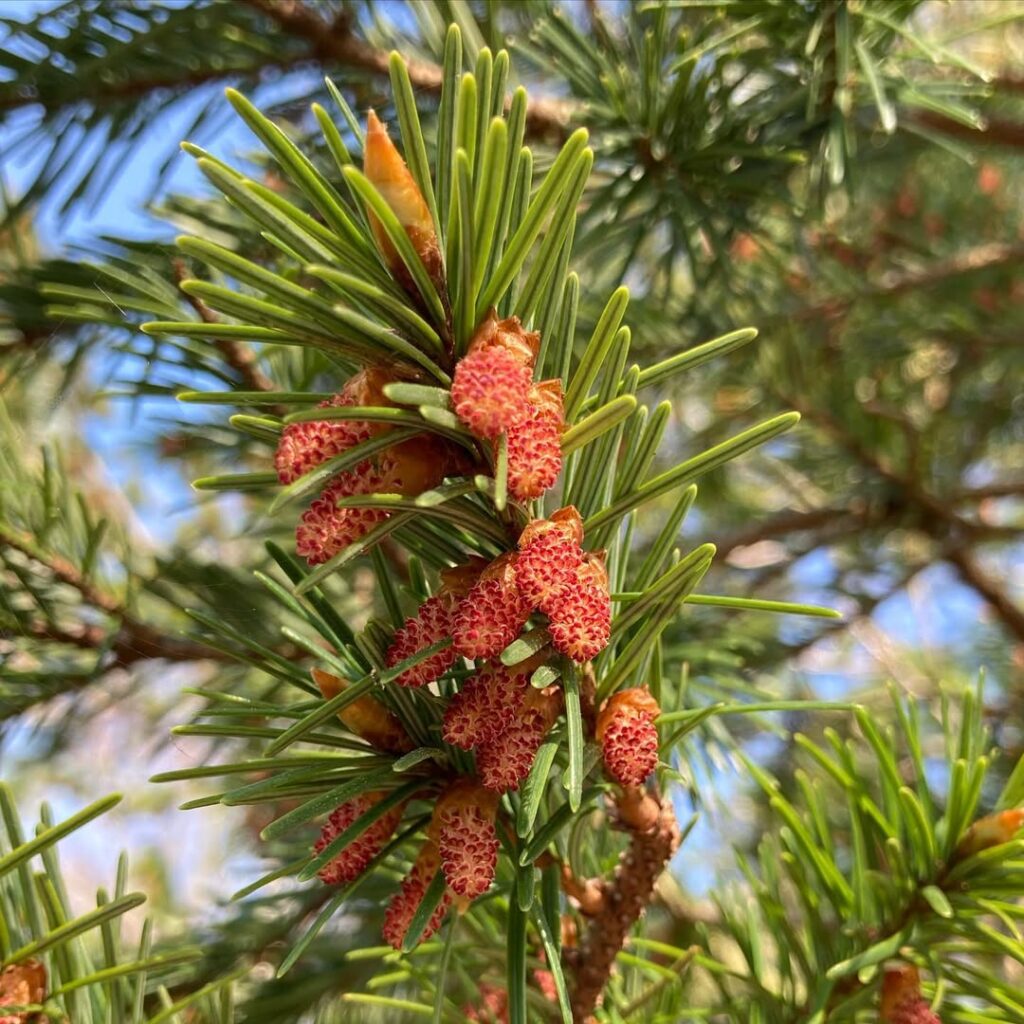
Douglas fir is Montana’s iconic evergreen conifer, reaching impressive heights of 35-45 meters in the Rocky Mountain variety. These long-lived trees, often exceeding 500 years, dominate Montana’s montane forests with their distinctive gray-green to blue-green needles and characteristic narrow conic buds. Found primarily east of the Continental Divide, Douglas fir thrives from valley bottoms to elevations of 7,500 feet.
The Rocky Mountain variety (Pseudotsuga menziesii var. glauca) is well-adapted to Montana’s continental climate, tolerating harsh winters and dry conditions better than its coastal counterpart. Young trees display smooth gray bark with resin blisters, while mature specimens develop thick, furrowed bark. These hardy conifers serve as keystone species in Montana’s forest ecosystems. The species can be easily identified by its distinctive forked cone bracts that distinguish it from other conifers in the region.
- Hardiness: USDA zones 3-6, extremely cold tolerant to -40°F
- Light: Full sun to partial shade, adaptable to various light conditions
- Water: Moderate water needs, drought tolerant once established, 20-40 inches annual precipitation
- Soil: Well-drained soils, tolerates various soil types from sandy to clay, pH 6.0-7.5
- Fertilizer: Generally requires no supplemental fertilization in native settings
- Pest/Disease Resistance: Good resistance to most pests and diseases when properly sited
- Growth Rate: Moderate to slow, 12-24 inches per year depending on conditions
Lodgepole Pine (Pinus Contorta)

Lodgepole pine (Pinus contorta) is Montana’s hardy native conifer, thriving throughout the western two-thirds of the state from elevations of 975 to 2,743 meters. This aggressive colonizer dominates upper montane to subalpine zones, rapidly establishing dense, even-aged stands following stand-replacing fires.
Known for its fire-adapted ecology, lodgepole pine quickly colonizes disturbed areas and maintains dominance through frequent fire cycles historically occurring every 50-300 years. This shade-intolerant species demonstrates remarkable ecological amplitude, growing on flats, slopes, and valley bottoms across various aspects and topographic conditions. Old unburned stands eventually break up after 100-200 years without fire and insect disturbance, giving way to shade-tolerant conifers.
- Hardiness: Extremely cold hardy, surviving temperatures well below freezing in subalpine conditions
- Light: Full sun; shade-intolerant species requiring open growing conditions
- Water: Moderate water needs; drought tolerant once established
- Soil: Adaptable to various soil types; grows on different topographic and edaphic conditions
- Fertilizer: Low fertility requirements; thrives in nutrient-poor mountain soils
- Pest/Disease Resistance: Susceptible to mountain pine beetle and dwarf mistletoe
- Growth Rate: Fast initial growth rate, especially after fire disturbance
Montana’s Essential Native Shrubs
Montana’s diverse climate supports numerous native shrub species that provide wildlife habitat, food sources, and natural beauty while thriving in the state’s variable environmental conditions. These hardy plants include species like Trilobe Sumac, which forms dense thickets that offer essential cover for birds and mammals throughout the seasons.
Serviceberry (Amelanchier Alnifolia)

Serviceberry (Amelanchier alnifolia) is a versatile native shrub or small tree in the Rose family, typically reaching 1-4 meters tall. This deciduous plant produces stunning white spring blooms followed by edible bluish-purple berries that ripen in late summer. The fruit tastes similar to blueberries and provides essential food for wildlife while offering culinary uses for humans.
Found throughout Montana’s diverse habitats from riparian areas to upland woods, serviceberry thrives in elevations between 4,500-9,000 feet. Its suckering growth habit creates dense thickets, making it valuable for erosion control and wildlife habitat. The plant’s striking autumn foliage and early spring flowers make it an excellent ornamental choice for naturalized landscapes. This species provides nectar and pollen for bees during spring blooming periods, supporting local pollinator populations when they need to build up their colonies.
- Hardiness: USDA zones 2-6, cold hardy through Montana winters
- Light: Full sun to partial shade; full sun promotes better flowering and fruiting
- Water: Drought-tolerant once established; prefers moderate moisture for ideal fruit production
- Soil: Adaptable to various soil types including dry, well-drained, acidic, or limestone-rich substrates
- Fertilizer: Low maintenance; typically requires no supplemental fertilization in native settings
- Pest/Disease Resistance: Generally resistant; may encounter aphids or rusts but rarely severely affected
- Growth Rate: Moderate; begins fruit production 2-3 years after planting
Chokecherry (Prunus Virginiana)
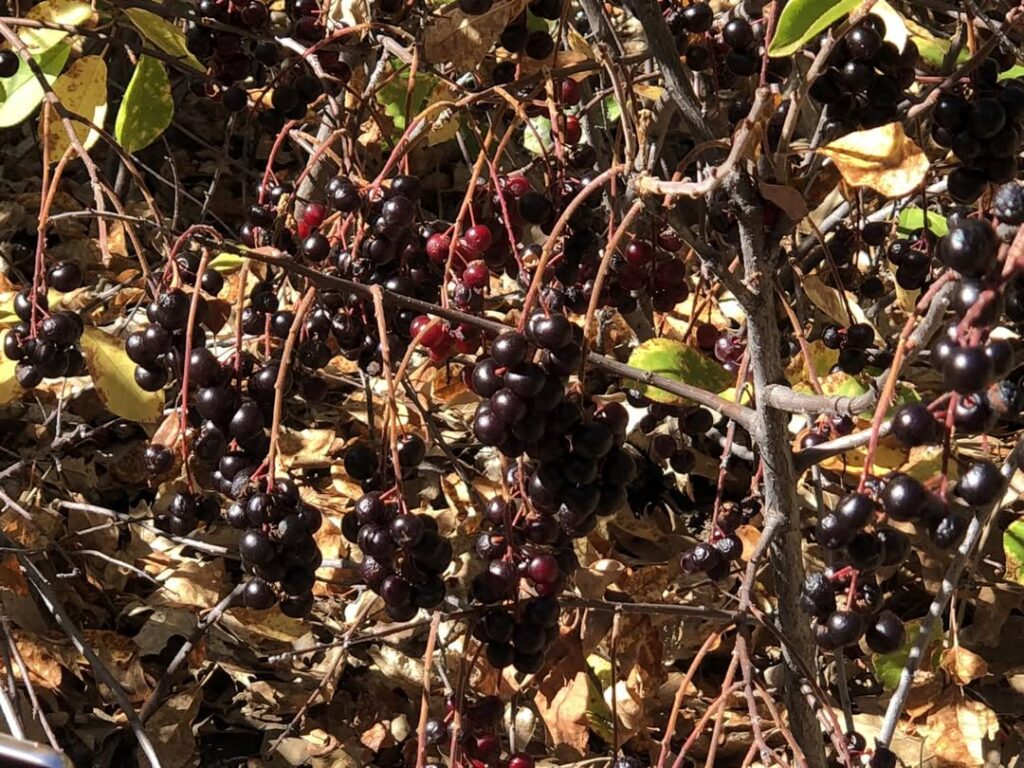
Chokecherry (Prunus virginiana) is one of Montana’s most valuable native shrubs, thriving across diverse habitats from riparian areas to rocky slopes at elevations between 2,500 and 8,000 feet. This adaptable shrub grows 3-20 feet tall, producing fragrant white flower clusters in spring followed by deep red to black cherries in late summer.
The species provides critical wildlife habitat and food, supporting birds, mammals, and pollinators while stabilizing soils with its extensive root system. Dense thickets offer nesting sites and shelter for various wildlife species, making it an essential component of Montana’s native ecosystems. The sour fruits are commonly transformed into preserves and wine, adding culinary value to this versatile native plant.
- Hardiness: USDA Zone 2a; extremely cold tolerant
- Light: Full sun to partial shade
- Water: Drought tolerant once established; tolerates variable moisture conditions
- Soil: Adaptable to poor, disturbed, or stony soils; prefers well-drained conditions
- Fertilizer: None required; thrives in native soil conditions
- Pest/Disease Resistance: Generally hardy but susceptible to black knot disease and some fungal issues
- Growth Rate: Moderate to fast; spreads vigorously through suckers to form thickets
Snowberry (Symphoricarpos Albus)
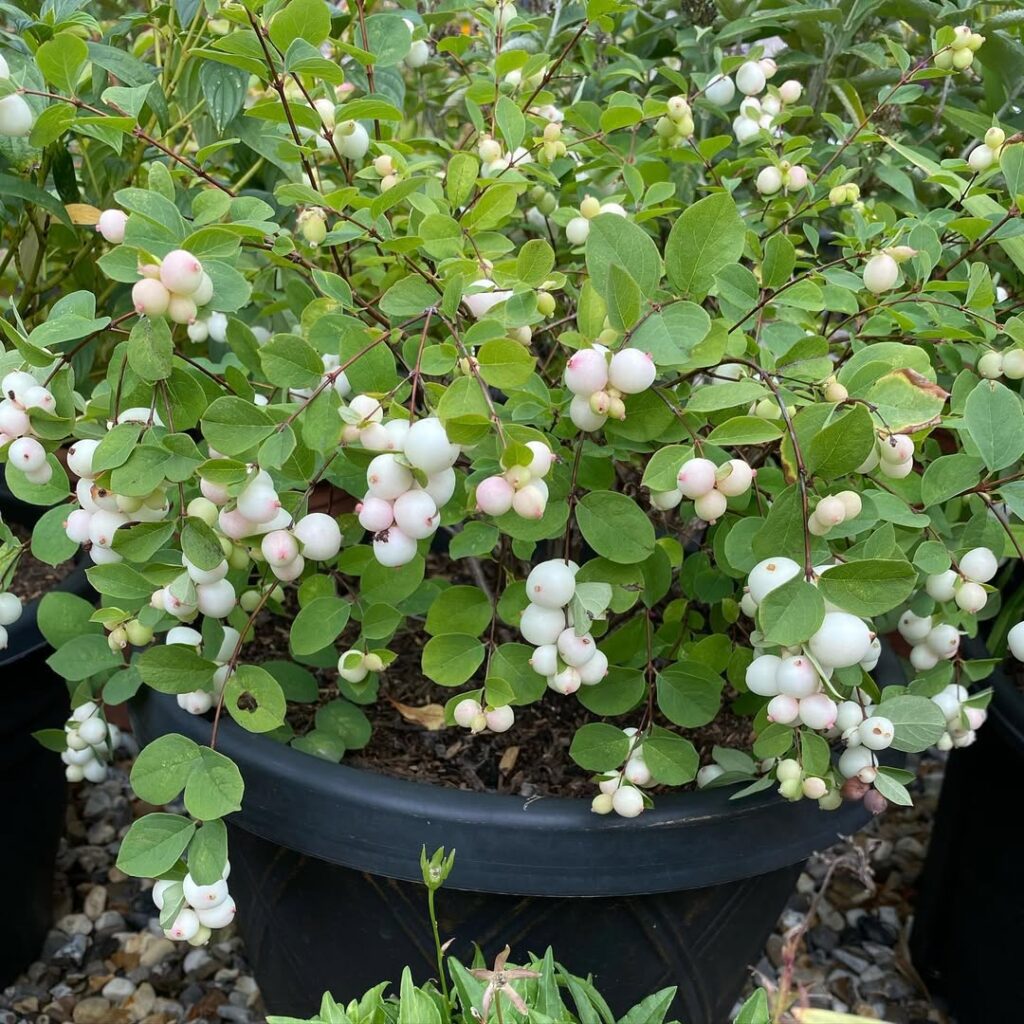
Snowberry is a widespread native shrub found throughout Montana and much of North America. This deciduous shrub typically grows 2-5 feet tall, forming dense thickets with thin, branched stems and small ovate leaves. It produces clusters of small pinkish-white, bell-shaped flowers followed by distinctive white, berry-like drupes that persist into winter.
This hardy shrub provides exceptional ecological value, offering food for birds and small mammals while hosting caterpillars of the snowberry clearwing moth. Its dense thicket structure creates excellent wildlife cover and nesting habitat. Snowberry is highly valued for erosion control, naturalistic plantings, and restoration projects due to its adaptability and resilience. The plant belongs to the Caprifoliaceae family, commonly known as the honeysuckle family.
- Hardiness: USDA zones 2-7, extremely cold tolerant to subarctic conditions
- Light: Full sun to partial shade
- Water: Drought tolerant once established, adapts to dry to moderately moist conditions
- Soil: Tolerates various soil types including clay, loam, and sandy soils
- Fertilizer: No supplemental fertilization needed, thrives in native soils
- Pest/Disease Resistance: Excellent resistance, browsing resistant due to mildly toxic compounds
- Growth Rate: Moderate to fast, spreads by underground stems to form colonies
Rocky Mountain Maple (Acer)

The Rocky Mountain Maple (Acer glabrum) is a versatile multi-stemmed shrub or small tree native to Montana’s mountainous regions. Growing 10-30 feet tall, this hardy species features distinctive three to five-lobed leaves that transform from glossy green to brilliant yellow-orange in fall. Its smooth gray bark and reddish winged seeds provide year-round visual interest.
As Montana’s northernmost native maple species, it thrives in wooded hills and stream valleys above 4,500 feet elevation. The fragrant spring blooms and delicate branching pattern make it an excellent choice for naturalistic landscapes, offering brilliant fall color while maintaining a compact crown suitable for smaller garden spaces. This valuable native plant provides important wildlife browse for deer, elk, cattle, and sheep throughout its range.
- Hardiness: Cold hardy in Montana mountain zones, tolerates elevations above 4,500 feet
- Light: Partial shade preferred for ideal growth
- Water: Adequate moisture required, protection from wind necessary
- Soil: Highly organic soil preferred, adaptable to rocky terrain and various soil conditions
- Fertilizer: Minimal fertilizer needs as a native species
- Pest/Disease Resistance: Generally hardy and disease resistant when grown in appropriate conditions
- Growth Rate: Moderate growth rate, reaching mature size of 10-30 feet
Sagebrush (Artemisia Tridentata)
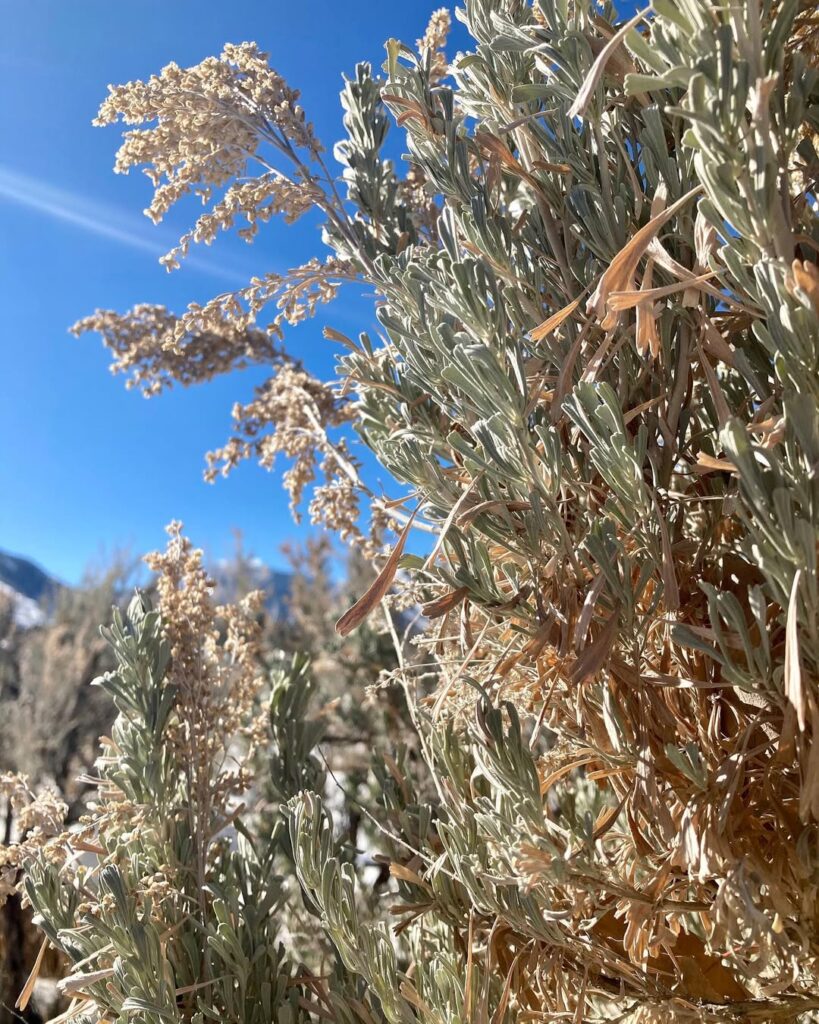
Big sagebrush (Artemisia tridentata) stands as Montana’s most iconic native shrub, dominating the state’s plains, valleys, and subalpine slopes. This keystone species covers vast areas of the western landscape, serving as critical habitat for sage grouse, pronghorn, and mule deer while supporting exceptional biodiversity in sagebrush steppe ecosystems.
Characterized by its distinctive three-lobed, gray-green aromatic leaves and persistent woody stems, big sagebrush varies dramatically in size and form across its six recognized subspecies. From basin floors to mountain ridges, this hardy shrub adapts to diverse elevations and conditions, with lifespans extending over a century. Its deep root systems provide essential soil stability and erosion control in Montana’s semi-arid landscapes. The plant’s extensive taproot system can reach depths of 1-4 meters, allowing it to access both surface precipitation and deep groundwater sources unavailable to most other vegetation.
- Hardiness: Zones 4-8, extremely cold tolerant with documented survival at elevations up to 10,800 feet
- Light: Full sun, thrives in open exposed locations with minimal shade tolerance
- Water: Low to moderate water needs, adapted to 7-15.5 inches annual precipitation, drought tolerant once established
- Soil: Well-draining soils preferred, tolerates poor soils, alkaline conditions, and various soil types from sandy to clay
- Fertilizer: No fertilizer needed, adapted to nutrient-poor soils and may be harmed by excessive nutrients
- Pest/Disease Resistance: Generally resistant to most pests and diseases, well-adapted to harsh environmental conditions
- Growth Rate: Slow to moderate, taking several years to establish with potential lifespans of 5-109 years
Selecting the Right Native Plants for Your Garden
Creating a thriving native garden starts with understanding your specific site conditions, because Montana’s diverse landscapes demand careful plant selection. You’ll need to assess your soil type, sun exposure, and water availability before choosing plants.
Plant compatibility becomes essential when grouping species with similar needs. Consider these important factors:
- Soil drainage – Most natives prefer well-drained conditions over soggy ground
- Sun requirements – Match full-sun lovers with sunny spots, shade plants with protected areas
- Water tolerance – Group drought-resistant species together for easier garden maintenance
Source plants from reputable native nurseries, and you’ll establish a low-maintenance garden that supports local wildlife while thriving in Montana’s challenging climate. Resources like the Plant Something Montana database can provide targeted recommendations based on your specific growing conditions and regional requirements.
Frequently Asked Questions
How Long Do Montana Native Plants Take to Establish After Planting?
You’ll find Montana native plants have an establishment timeline of two to three years before they’re fully rooted. Growth factors like competition suppression, adequate irrigation, and proper seasonal planting greatly influence their successful establishment.
Can Montana Native Plants Survive Drought Conditions Without Supplemental Watering?
You’ll find that established Montana natives demonstrate excellent drought resilience, surviving on 11 inches of annual precipitation without supplemental watering. They’re perfect for water conservation, though riparian species like willows need extra moisture.
Which Native Plants Attract Pollinators Like Bees and Butterflies in Montana?
Like nature’s colorful buffet spread across the landscape, you’ll create thriving pollinator gardens with Purple Coneflower, Blanketflower, Penstemon, and Milkweed. These natives establish excellent bee habitats while attracting butterflies throughout Montana’s growing season.
Do Montana Native Plants Require Special Soil Amendments or Fertilizers?
You don’t need special fertilizers for Montana native plants since they’re adapted to local conditions. Focus on matching soil pH and natural nutrient requirements rather than adding amendments once they’re established.
When Is the Best Time of Year to Plant Native Species?
Strike while the iron’s hot with spring planting from late May to early June after frost danger passes. You’ll find fall planting works better for establishing infrastructure, but spring’s your sweet spot for native species success.
